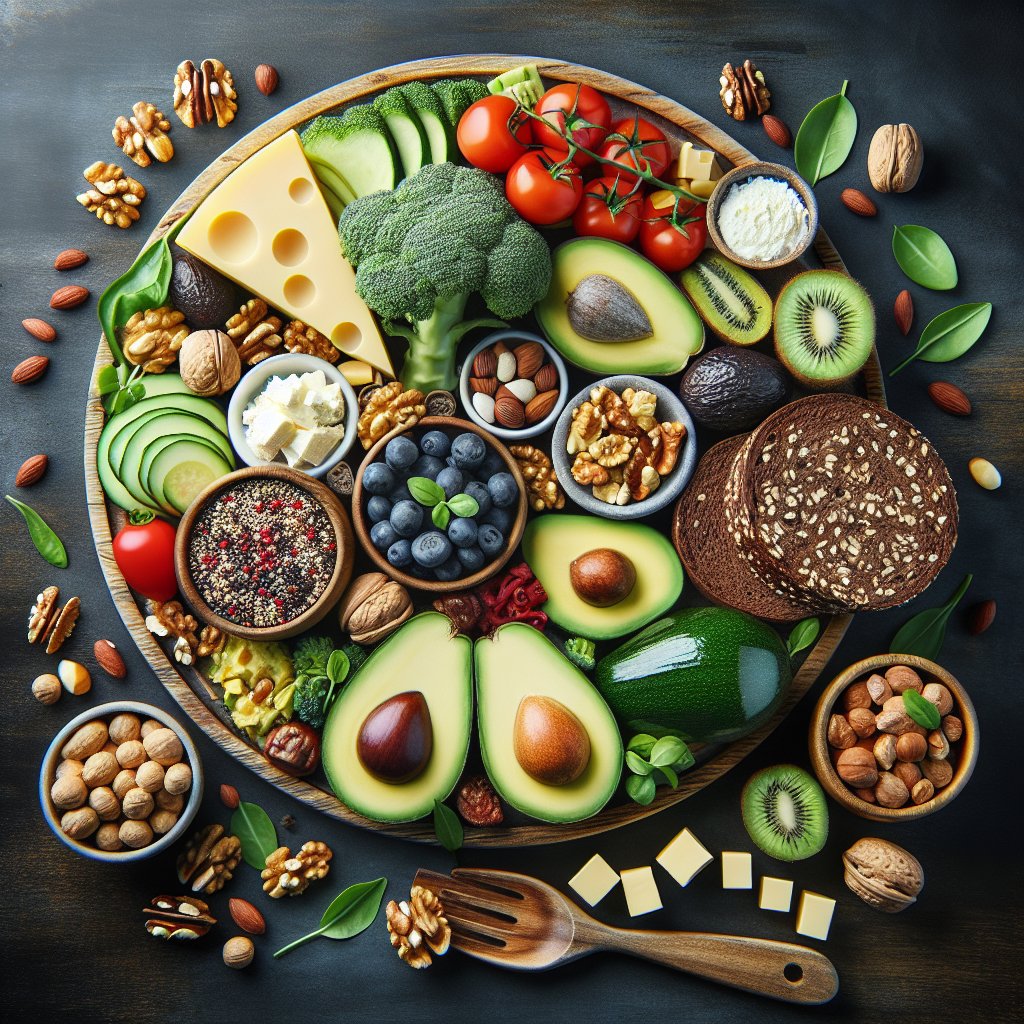Can You Eat Gluten-Free Bread on Keto? Exploring Nutritional Comparison, Best Brands, and Homemade Recipes!
Can You Eat Gluten-Free Bread on Keto?
Hey there, keto enthusiasts! If you’re here, you’re probably on a quest for delicious keto-friendly bread options that won’t throw you out of ketosis. The ketogenic diet, or keto diet, is all about consuming low-carb, high-fat foods to encourage your body to enter a state of ketosis, where it burns fat for fuel instead of carbs. This metabolic state can lead to weight loss, improved energy levels, and enhanced mental clarity.
Research has shown that the keto diet can help reduce body weight, body mass index, and body fat percentage, while also improving levels of HDL cholesterol (the “good” cholesterol) in the body. As we delve into the world of gluten-free bread on keto, let’s explore the nutritional comparisons, the best brands, and even some fantastic homemade recipes that’ll keep you on track with your keto goals. So, can you eat gluten-free bread on keto? Let’s find out!

Can You Eat Gluten-Free Bread on Keto?
Discussion on the Suitability of Gluten-Free Bread on Keto Diet
One of the common queries among individuals following the ketogenic lifestyle is whether gluten-free bread is suitable for the keto diet. Let’s delve into this and explore the nutritional comparison, best brands, and homemade recipes. Since the keto diet is centered around consuming minimal carbs and promoting fat-burning, the suitability of gluten-free bread comes into question due to its potential impact on blood sugar levels.
Research has shown that some gluten-free bread can still have a high glycemic index, causing a spike in blood sugar levels. This may not align with the goals of the keto diet, which aims to maintain stable blood sugar and ketone levels for fat burning. It’s essential to prioritize bread with low net carbs and high fiber content, which is more compatible with the keto diet.
Stay tuned as we analyze nutritional aspects and provide recommendations for incorporating gluten-free bread into a keto-friendly diet!
Comparison of Nutritional Values
When it comes to bread, not all options are created equal, especially on a keto diet. Let’s take a closer look at the nutritional values of regular bread, gluten-free bread, and keto-friendly options.
Regular Bread
Regular bread is typically made from refined wheat flour, which is high in carbohydrates. Two slices of white bread can contain around 26 grams of carbs, which is more than half of the daily carb intake for some people following a keto diet. Additionally, regular bread is low in healthy fats and protein.
Gluten-Free Bread
Gluten-free bread is often made from alternative flours such as rice, almond, or coconut flour. While it is lower in carbs compared to regular bread, it still may not be the best option for keto due to its moderate to high carbohydrate content. It’s essential to check labels as some gluten-free bread can contain added sugars and starchy fillers.
Keto-Friendly Options
Keto-friendly bread, on the other hand, is specifically formulated to be low in carbohydrates and high in fats and fiber. It typically contains ingredients such as almond flour, coconut flour, psyllium husk, and eggs, which contribute to a higher fat and protein content. This makes it a suitable choice for those following a keto diet.
Overall, when choosing bread on a keto diet, it’s crucial to consider the nutritional values and opt for keto-friendly options that are low in carbs and high in healthy fats and fiber.
Ingredients in Gluten-Free Bread
Gluten-free bread has become a popular choice for individuals with celiac disease, gluten sensitivities, or those following a ketogenic lifestyle. However, it’s essential to analyze the common ingredients found in gluten-free bread and their impact on ketosis.
Almond Flour
Almond flour is a common ingredient in gluten-free bread. It’s low in carbs and high in healthy fats and fiber, making it a suitable option for those following a keto diet. Research published in the Journal of Nutrition and Metabolism suggests that including almond flour in a low-carbohydrate meal can help in improving weight and lipid profiles.
Coconut Flour
Coconut flour is another staple in gluten-free and keto baking. It contains a high amount of fiber and has a low glycemic index, which means it has minimal impact on blood sugar levels. A study in the European Journal of Nutrition found that coconut flour can help in managing blood sugar levels and reducing the risk of heart disease.
Psyllium Husk
Psyllium husk is often used as a binding agent in gluten-free bread. It is rich in soluble fiber and has been shown in a study in the Journal of Food Science and Technology to aid in improving gut health and promoting satiety, which can be beneficial for individuals on a keto diet.
When choosing gluten-free bread for keto, consider the ingredients and their impact on your ketosis goals. The right combination of ingredients can make gluten-free bread a viable option for your ketogenic lifestyle.
Best Gluten-Free Bread Brands for Keto
When it comes to the keto diet, finding gluten-free bread that is low in carbs and high in fiber and healthy fats can be challenging. However, there are a few specific gluten-free bread brands that align well with the keto diet.
1. Base Culture
Base Culture offers almond flour bread that is gluten-free, keto-friendly, and low in carbs. It’s made with high-quality, simple ingredients and is perfect for those following a ketogenic lifestyle.
2. ThinSlim Foods
ThinSlim Foods provides a variety of gluten-free bread and bagels that are not only low in carbs but also high in fiber. Their products are specifically crafted for those following low-carb diets like keto.
3. Sola
Sola bread is another great option for individuals on the keto diet. It’s gluten-free, low in carbs, and high in fiber, making it a suitable choice for those looking for a bread alternative while following a ketogenic lifestyle.
These brands offer gluten-free bread options that are not only keto-friendly but also delicious and satisfying, allowing you to enjoy bread while staying in ketosis.

Homemade Keto-Friendly Bread Recipe
Are you ready to elevate your keto diet game with a delicious homemade gluten-free bread? Look no further because we’ve got a fantastic recipe for you! This keto-friendly bread is not only gluten-free but also packed with healthy fats and low in carbs, making it a perfect addition to your ketogenic lifestyle.
Ingredients
Here’s what you’ll need to whip up a loaf of this delightful keto-friendly bread:
- 1 cup almond flour
- 1/4 cup coconut flour
- 1/4 cup ground flaxseed
- 1/4 cup psyllium husk powder
- 1 teaspoon baking powder
- 1/2 teaspoon salt
- 4 eggs
- 1/4 cup melted coconut oil
- 1 teaspoon apple cider vinegar
- Sesame seeds or pumpkin seeds for topping (optional)
These wholesome ingredients come together to create a bread that’s not only keto-friendly but also incredibly tasty and satisfying.
Practical Tips for Incorporating Gluten-Free Bread into Keto Diet
Yes, you can include gluten-free bread in your keto meal plan, but it’s essential to choose wisely to maintain ketosis. Here are some practical tips to enjoy gluten-free bread while staying in ketosis:
1. Check the Net Carbs
Opt for gluten-free bread with the lowest net carbs, as this can impact blood sugar levels and ketosis. Look for options with 2-4 grams of net carbs per serving.
2. Proper Portion Control
Limit your serving size to stay within your daily carb limit. Keeping portions small helps avoid spiking blood sugar levels and supports ketosis.
3. Pair with Healthy Fats and Proteins
Combine your gluten-free bread with healthy fats like avocado, olive oil, or nut butter to balance the macronutrients and keep your keto meal satisfying.
4. Make Open-Faced Sandwiches
Consider making open-faced sandwiches with just one slice of gluten-free bread to further reduce carb intake and ensure ketosis.
By following these practical tips, you can successfully incorporate gluten-free bread into your keto meal plan while achieving your dietary goals.
Potential Risks or Drawbacks
While gluten-free bread may seem like the perfect solution for those on a keto diet, there are some potential risks and drawbacks to consider. Many gluten-free bread options are made with starchy ingredients like rice flour, potato flour, and tapioca starch. These ingredients are high in carbohydrates and can spike blood sugar levels, potentially hindering ketosis. Additionally, some gluten-free bread may lack essential nutrients and fiber found in whole grain or low-carb bread.
Moreover, gluten-free products are often processed and may contain additives to improve texture and shelf life. Some individuals may also experience digestive issues due to xanthan gum or other binding agents commonly used in gluten-free bread.
It’s crucial to check the nutritional labels and ingredients of gluten-free bread carefully. While some keto-friendly options exist, moderation is key to avoid consuming excess carbs and additives that can impact your ketosis journey.
Conclusion: Can You Eat Gluten-Free Bread on Keto?
After exploring the nutritional aspects, best brands, and homemade recipes of gluten-free bread, it is evident that incorporating it into a keto diet is possible. While it’s crucial to pay attention to the carb content, there are several low-carb, high-fiber options available in the market. These breads are often rich in healthy fats and protein, which are beneficial for maintaining ketosis and feeling satiated.
However, it’s important to approach gluten-free bread as an occasional treat rather than a daily staple. Moderation and mindful consumption should be the focus. Additionally, homemade keto-friendly bread recipes can provide more control over the ingredients and ensure minimal or no impact on blood sugar levels.
Ultimately, whether you can eat gluten-free bread on keto boils down to individual tolerance, preferences, and goals. With the right choices and mindful indulgence, gluten-free bread can be a delightful addition to a ketogenic lifestyle.


